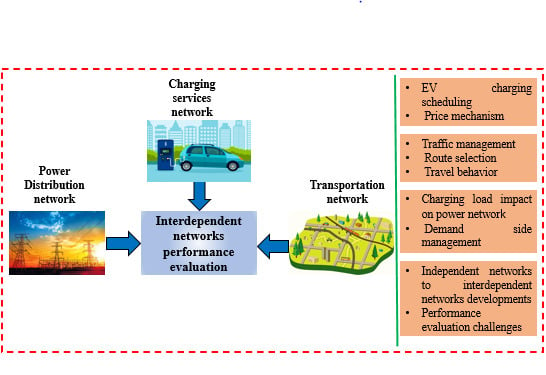Electrical Vehicle Charging Services Planning and Operation with Interdependent Power Networks and Transportation Networks: A Review of the Current Scenario and Future Trends
Abstract
1. Introduction
- (1)
- An extensive background study of power and transportation networks is provided to analyze the optimal operation and planning of an EV charging network infrastructure, including a performance index to predict the mobility of the vehicles and enhance the quality of service (QoS) and price strategies under the influence of multiple factors.
- (2)
- Technical strategies for interdependent relationships across the charging service, transportation, and power networks were determined to devise charging load scheduling and traffic congestion constraints and to analyze driving range extension and power load constraints.
- (3)
- Several potential research directions are highlighted that can add significant benefits to investigate interdependent charging service, power distribution, and transportation network expansion.
2. Charging Service Networks’ Planning and Operation
2.1. Electrical Vehicles Charging Load Forecasting Evaluation
2.2. Charging Services Network Price Mechanism Analysis
3. Transportation Network Traffic Assignments Problems Evaluation
Vehicle Routing and Charging Operations Analysis
4. Interdependent Networks Correlation Challenges and Applications
4.1. Interdependent Networks Cooperative Planning and Operations Analysis
4.2. Three-Ways Networks Modeling and Coupling Association
4.3. Three Networks Integration Technical Challenges Regarding Performance Evaluation
5. Discussion and Future Research Prospects
6. Conclusions
Author Contributions
Funding
Conflicts of Interest
References
- Outlook, IEA Global EV. To Electric Mobility; IEA: Paris, France, 2019; Available online: https://www.iea.org/reports/global-ev-outlook-2019 (accessed on 15 October 2019).
- Motors, Tesla. Tesla Motors-High Performance Electric Vehicles. 2010. Available online: http://www.teslamotors.com (accessed on 28 April 2019).
- Grunditz, E.A.; Thiringer, T. Performance analysis of current BEVs based on a comprehensive review of Specifications. IEEE Trans. Transp. Electr. 2016, 2, 270–289. [Google Scholar] [CrossRef]
- Marmaras, C.; Xydas, E.; Cipcigan, L. Simulation of electric vehicle driver behaviour in road transport and electric power networks. Transp. Res. Part C Emerg. Technol. 2017, 80, 239–256. [Google Scholar] [CrossRef]
- The Economist. The Hidden Cost of Congestion. 2018. Available online: https://www.economist.com/graphic-detail/2018/02/28/the-hidden-cost-of-congestion (accessed on 16 February 2019).
- Richardson, P.; Flynn, D.; Keane, A. Optimal charging of electric vehicles in low-voltage distribution systems. IEEE Trans. Power Syst. 2011, 27, 268–279. [Google Scholar] [CrossRef]
- Sarker, M.; Ortega-Vazquez, M.A.; Kirschen, D.S. Optimal coordination and scheduling of demand response via monetary incentives. IEEE Trans. Smart Grid 2015, 6, 1341–1352. [Google Scholar] [CrossRef]
- Wei, W.; Liu, F.; Mei, S. Energy pricing and dispatch for smart grid retailers under demand response and market price uncertainty. IEEE Trans. Smart Grid 2015, 6, 1364–1374. [Google Scholar] [CrossRef]
- Kazemi, M.A.; Sedighizadeh, M.; Mirzaei, M.J.; Homaee, O. Optimal siting and sizing of distribution system operator owned EV parking lots. Appl. Energy 2016, 179, 1176–1184. [Google Scholar] [CrossRef]
- Zhang, H.; Hu, Z.; Xu, Z.; Song, Y. An integrated planning framework for different types of PEV charging facilities in urban area. IEEE Trans. Smart Grid 2015, 7, 1. [Google Scholar] [CrossRef]
- Amini, M.H.; Moghaddam, M.P.; Karabasoglu, O. Simultaneous allocation of electric vehicles’ parking lots and distributed renewable resources in smart power distribution networks. Sustain. Cities Soc. 2017, 28, 332–342. [Google Scholar] [CrossRef]
- Mohammadi-Hosseininejad, S.M.; Fereidunian, A.; Lesani, H.; Nezhad, S.M.H. Reliability improvement considering plug-in hybrid electric vehicles parking lots ancillary services: A stochastic multi-criteria approach. IET Gener. Transm. Distrib. 2018, 12, 824–833. [Google Scholar] [CrossRef]
- Yang, Z.; Sun, L.; Chen, J.; Yang, Q.; Chen, X.; Xing, K. Profit maximization for plug-in electric taxi with uncertain future electricity prices. IEEE Trans. Power Syst. 2014, 29, 3058–3068. [Google Scholar] [CrossRef]
- Xiang, Y.; Yang, W.; Liu, J.; Li, F. Multi-objective distribution network expansion incorporating electric vehicle charging stations. Energies 2016, 9, 909. [Google Scholar] [CrossRef]
- Vayá, M.G.; Andersson, G. Optimal bidding of plug-in electric vehicle aggregator in day-ahead and regulation markets. Int. J. Electr. Hybrid Veh. 2015, 7, 209. [Google Scholar] [CrossRef]
- Tan, L.; Wu, B.; Rivera, S.; Yaramasu, V. Comprehensive DC power balance management in high-power three-level dc–dc converter for electric vehicle fast charging. IEEE Trans. Power Electron. 2015, 31, 89–100. [Google Scholar] [CrossRef]
- Tu, H.; Feng, H.; Srdic, S.; Lukic, S.M. Extreme fast charging of electric vehicles: A technology overview. IEEE Trans. Transp. Electr. 2019, 5, 861–878. [Google Scholar] [CrossRef]
- Ronanki, D.; Kelkar, A.; Williamson, S. Extreme fast charging technology—Prospects to enhance sustainable electric transportation. Energies 2019, 12, 3721. [Google Scholar] [CrossRef]
- Lee, M.; Yeh, C.-S.; Yu, O.; Kim, J.-W.; Choe, J.-M.; Lai, J.-S. Modeling and control of three-level boost rectifier based medium-voltage solid-state transformer for dc fast charger application. IEEE Trans. Transp. Electr. 2019, 5, 890–902. [Google Scholar] [CrossRef]
- Viana, C.; Lehn, P.W. A drivetrain integrated DC fast charger with buck and boost functionality and simultaneous drive/charge capability. IEEE Trans. Transp. Electr. 2019, 5, 903–911. [Google Scholar] [CrossRef]
- Ucer, E.; Koyuncu, I.; Kisacikoglu, M.; Yavuz, M.; Meintz, A.L.; Rames, C. Modeling and analysis of a fast charging station and evaluation of service quality for electric vehicles. IEEE Trans. Transp. Electr. 2019, 5, 215–225. [Google Scholar] [CrossRef]
- Gan, L.; Topcu, U.; Low, S.H. Optimal decentralized protocol for electric vehicle charging. IEEE Trans. Power Syst. 2012, 28, 940–951. [Google Scholar] [CrossRef]
- Shuai, W.; Maille, P.; Pelov, A. Charging electric vehicles in the smart city: A survey of economy-driven approaches. IEEE Trans. Intell. Transp. Syst. 2016, 17, 2089–2106. [Google Scholar] [CrossRef]
- Rezaee, S.; Farjah, E.; Khorramdel, B. Probabilistic analysis of plug-in electric vehicles impact on electrical grid through homes and parking lots. IEEE Trans. Sustain. Energy 2013, 4, 1024–1033. [Google Scholar] [CrossRef]
- Qian, K.; Allan, M.; Zhou, C.; Yuan, Y. Modeling of load demand due to ev battery charging in distribution systems. IEEE Trans. Power Syst. 2010, 26, 802–810. [Google Scholar] [CrossRef]
- Wai, C.K.; Rong, Y.Y.; Morris, S. Simulation of a distance estimator for battery electric vehicle. Alex. Eng. J. 2015, 54, 359–371. [Google Scholar] [CrossRef]
- Shao, C.; Wang, X.; Wang, X.; Du, C.; Wang, B. Hierarchical charge control of large populations of EVs. IEEE Trans. Smart Grid 2015, 7, 1. [Google Scholar] [CrossRef]
- Ammous, M.; Belakaria, S.; Sorour, S.; Abdel-Rahim, A. Optimal cloud-based routing with in-route charging of mobility-on-demand electric vehicles. IEEE Trans. Intell. Transp. Syst. 2019, 20, 2510–2522. [Google Scholar] [CrossRef]
- Cerna, F.V.; Kasmaei, M.P.; Romero, R.; Rider, M.J.; Pourakbhari-Kasmaei, M. Optimal delivery scheduling and charging of evs in the navigation of a city map. IEEE Trans. Smart Grid 2017, 9, 4815–4827. [Google Scholar] [CrossRef]
- Liu, C.; Zhou, M.; Wu, J.; Long, C.; Wang, Y. Electric vehicles en-route charging navigation systems: Joint charging and routing optimization. IEEE Trans. Control. Syst. Technol. 2017, 27, 906–914. [Google Scholar] [CrossRef]
- Shi, R.; Liu, J.; Liao, Z.; Niu, L.; Ibrahim, E.; Fu, F. An electric taxi charging station planning scheme based on an improved destination choice method. Energies 2019, 12, 3781. [Google Scholar] [CrossRef]
- Guo, Q.; Xin, S.; Sun, H.; Li, Z.; Zhang, B. Rapid-charging navigation of electric vehicles based on real-time power systems and traffic data. IEEE Trans. Smart Grid 2014, 5, 1969–1979. [Google Scholar] [CrossRef]
- Tang, D.; Wang, P. Probabilistic modeling of nodal charging demand based on spatial-temporal dynamics of moving electric vehicles. IEEE Trans. Smart Grid 2015, 7, 1. [Google Scholar] [CrossRef]
- Luo, Y.; Zhu, T.; Wan, S.; Zhang, S.; Li, K. Optimal charging scheduling for large-scale EV (electric vehicle) deployment based on the interaction of the smart-grid and intelligent-transport systems. Energy 2016, 97, 359–368. [Google Scholar] [CrossRef]
- Hilton, G.; Kiaee, M.; Bryden, T.S.; Dimitrov, B.; Cruden, A.; Mortimer, A. A stochastic method for prediction of the power demand at high rate ev chargers. IEEE Trans. Transp. Electr. 2018, 4, 744–756. [Google Scholar] [CrossRef]
- Li, M.; Lenzen, M.; Keck, F.; McBain, B.; Rey-Lescure, O.; Li, B.; Jiang, C. GIS-based probabilistic modeling of bev charging load for Australia. IEEE Trans. Smart Grid 2018, 10, 3525–3534. [Google Scholar] [CrossRef]
- Li, M.; Lenzen, M.; Wang, D.; Nansai, K. GIS-based modelling of electric-vehicle–grid integration in a 100% renewable electricity grid. Appl. Energy 2020, 262, 114577. [Google Scholar] [CrossRef]
- Xing, Q.; Chen, Z.; Zhang, Z.; Huang, X.; Leng, Z.; Sun, K.; Chen, Y.; Wang, H. Charging demand forecasting model for electric vehicles based on online ride-hailing trip data. IEEE Access 2019, 7, 137390–137409. [Google Scholar] [CrossRef]
- Chiou, S.-Y.; Tu, T.-Y. A trusted mobile ride-hailing evaluation system with privacy and authentication. IEEE Access 2020, 8, 61929–61942. [Google Scholar] [CrossRef]
- Park, D.; El-Sharkawi, M.; Marks, R.; Atlas, L.; Damborg, M. Electric load forecasting using an artificial neural network. IEEE Trans. Power Syst. 1991, 6, 442–449. [Google Scholar] [CrossRef]
- Hippert, H.S.; Pedreira, C.E.; Souza, R.C. Neural networks for short-term load forecasting: A review and evaluation. IEEE Trans. Power Syst. 2001, 16, 44–55. [Google Scholar] [CrossRef]
- Rigas, E.S.; Ramchurn, S.D.; Bassiliades, N. Managing electric vehicles in the smart grid using artificial intelligence: A survey. IEEE Trans. Intell. Transp. Syst. 2014, 16, 1619–1635. [Google Scholar] [CrossRef]
- Vázquez-Canteli, J.R.; Nagy, Z. Reinforcement learning for demand response: A review of algorithms and modeling techniques. Appl. Energy 2019, 235, 1072–1089. [Google Scholar] [CrossRef]
- Zhang, Y.; Haghani, A. A gradient boosting method to improve travel time prediction. Transp. Res. Part C Emerg. Technol. 2015, 58, 308–324. [Google Scholar] [CrossRef]
- Huang, X.; Chen, J.; Chen, Y.; Yang, H.; Cao, Y.; Jiang, L. Load forecasting method for electric vehicle charging station based on big data. Autom. Electr. Power Syst. 2016, 12, 68–74. [Google Scholar]
- Sun, S.; Zhang, J.; Bi, J.; Wang, Y. A machine learning method for predicting driving range of battery electric vehicles. J. Adv. Transp. 2019, 2019, 1–14. [Google Scholar] [CrossRef]
- Zhu, J.; Yang, Z.; Mourshed, M.; Li, K.; Zhou, Y.; Chang, Y.; Wei, Y.; Feng, S. Electric vehicle charging load forecasting: A comparative study of deep learning approaches. Energies 2019, 12, 2692. [Google Scholar] [CrossRef]
- Amini, M.H.; Mohammadi, J.; Kar, S. Distributed holistic framework for smart city infrastructures: Tale of interdependent electrified transportation network and power grid. IEEE Access 2019, 7, 157535–157554. [Google Scholar] [CrossRef]
- Zhang, B.; Kezunovic, M. Impact on power system flexibility by electric vehicle participation in ramp market. IEEE Trans. Smart Grid 2015, 7, 1. [Google Scholar] [CrossRef]
- Liu, H.; Hu, Z.; Song, Y.; Wang, J.; Xie, X. Vehicle-to-grid control for supplementary frequency regulation considering charging demands. IEEE Trans. Power Syst. 2014, 30, 1–10. [Google Scholar] [CrossRef]
- Vaya, M.G.; Andersson, G. Self scheduling of plug-in electric vehicle aggregator to provide balancing services for wind power. IEEE Trans. Sustain. Energy 2015, 7, 886–899. [Google Scholar] [CrossRef]
- Mohamed, A.; Salehi, V.; Ma, T.; Mohammed, O.A. Real-time energy management algorithm for plug-in hybrid electric vehicle charging parks involving sustainable energy. IEEE Trans. Sustain. Energy 2014, 5, 577–586. [Google Scholar] [CrossRef]
- Khodayar, M.E.; Wu, L.; Li, Z. Electric vehicle mobility in transmission-constrained hourly power generation scheduling. IEEE Trans. Smart Grid 2013, 4, 779–788. [Google Scholar] [CrossRef]
- Yilmaz, M.; Krein, P.T. Review of the impact of vehicle-to-grid technologies on distribution systems and utility interfaces. IEEE Trans. Power Electron. 2013, 28, 5673–5689. [Google Scholar] [CrossRef]
- Xu, N.Z.; Chan, K.W.; Chung, C.Y.; Niu, M. Enhancing adequacy of isolated systems with electric vehicle-based emergency strategy. IEEE Trans. Intell. Transp. Syst. 2019, 1–7. [Google Scholar] [CrossRef]
- Liu, H.; Qi, J.; Wang, J.; Li, P.; Li, C.; Wei, H. EV dispatch control for supplementary frequency regulation considering the expectation of ev owners. IEEE Trans. Smart Grid 2018, 9, 3763–3772. [Google Scholar] [CrossRef]
- Wenzel, G.; Negrete-Pincetic, M.; Olivares, D.E.; Macdonald, J.; Callaway, D.S. Real-time charging strategies for an electric vehicle aggregator to provide ancillary services. IEEE Trans. Smart Grid 2018, 9, 5141–5151. [Google Scholar] [CrossRef]
- Liu, H.; Huang, K.; Wang, N.; Liu, H.; Wu, Q.; Ma, S.; Li, C. Optimal dispatch for participation of electric vehicles in frequency regulation based on area control error and area regulation requirement. Appl. Energy 2019, 240, 46–55. [Google Scholar] [CrossRef]
- Deforest, N.; Macdonald, J.; Black, D.R. Day ahead optimization of an electric vehicle fleet providing ancillary services in the Los Angeles air force base vehicle-to-grid demonstration. Appl. Energy 2018, 210, 987–1001. [Google Scholar] [CrossRef]
- Koufakis, A.-M.; Rigas, E.S.; Bassiliades, N.; Ramchurn, S.D. Offline and online electric vehicle charging scheduling with V2V energy transfer. IEEE Trans. Intell. Transp. Syst. 2020, 21, 2128–2138. [Google Scholar] [CrossRef]
- Saldaña, G.; Martin, J.I.S.; Zamora, I.; Asensio, F.J.; Oñederra, O. Electric vehicle into the grid: Charging methodologies aimed at providing ancillary services considering battery degradation. Energies 2019, 12, 2443. [Google Scholar] [CrossRef]
- Zheng, Y.; Dong, Z.Y.; Xu, Y.; Meng, K.; Zhao, J.H.; Qiu, J. Electric vehicle battery charging/swap stations in distribution systems: Comparison study and optimal planning. IEEE Trans. Power Syst. 2013, 29, 221–229. [Google Scholar] [CrossRef]
- Infante, W.; Ma, J.; Han, X.; Liebman, A. Optimal recourse strategy for battery swapping stations considering electric vehicle uncertainty. IEEE Trans. Intell. Transp. Syst. 2020, 21, 1369–1379. [Google Scholar] [CrossRef]
- Wei, Z.; Li, Y.; Cai, L. Electric vehicle charging scheme for a park-and-charge system considering battery degradation costs. IEEE Trans. Intell. Veh. 2018, 3, 361–373. [Google Scholar] [CrossRef]
- Manshadi, S.D.; Khodayar, M.E.; Abdelghany, K.; Uster, H. wireless charging of electric vehicles in electricity and transportation networks. IEEE Trans. Smart Grid 2018, 9, 4503–4512. [Google Scholar] [CrossRef]
- Ou, C.-H.; Liang, H.; Zhuang, W. Investigating wireless charging and mobility of electric vehicles on electricity market. IEEE Trans. Ind. Electron. 2014, 62, 3123–3133. [Google Scholar] [CrossRef]
- Zhang, Y.; You, P.; Cai, L. Optimal charging scheduling by pricing for EV charging station with dual charging modes. IEEE Trans. Intell. Transp. Syst. 2019, 20, 3386–3396. [Google Scholar] [CrossRef]
- Tang, D.; Wang, P. Nodal impact assessment and alleviation of moving electric vehicle loads: From traffic flow to power flow. IEEE Trans. Power Syst. 2016, 31, 4231–4242. [Google Scholar] [CrossRef]
- Tan, J.; Wang, L. Real-time charging navigation of electric vehicles to fast charging stations: A hierarchical game approach. IEEE Trans. Smart Grid 2015, 8, 1. [Google Scholar] [CrossRef]
- Dong, X.; Mu, Y.; Xu, X.; Jia, H.; Wu, J.; Yu, X.; Qi, Y. A charging pricing strategy of electric vehicle fast charging stations for the voltage control of electricity distribution networks. Appl. Energy 2018, 225, 857–868. [Google Scholar] [CrossRef]
- Yang, Q.; Sun, S.; Deng, S.; Zhao, Q.; Zhou, M. optimal sizing of PEV fast charging stations with markovian demand characterization. IEEE Trans. Smart Grid 2019, 10, 4457–4466. [Google Scholar] [CrossRef]
- Cui, Q.; Weng, Y.; Tan, C.-W. Electric vehicle charging station placement method for urban areas. IEEE Trans. Smart Grid 2019, 10, 6552–6565. [Google Scholar] [CrossRef]
- Liu, W.-L.; Gong, Y.-J.; Chen, W.-N.; Liu, Z.; Wang, H.; Zhang, J. Coordinated charging scheduling of electric vehicles: A mixed-variable differential evolution approach. IEEE Trans. Intell. Transp. Syst. 2019, 1–16. [Google Scholar] [CrossRef]
- Moradipari, A.; Alizadeh, M. Pricing and routing mechanisms for differentiated services in an electric vehicle public charging station network. IEEE Trans. Smart Grid 2020, 11, 1489–1499. [Google Scholar] [CrossRef]
- Ghosh, A.; Aggarwal, V. Control of charging of electric vehicles through menu-based pricing under uncertainty. In Proceedings of the 2017 IEEE International Conference on Communications (ICC), Paris, France, 21–25 May 2017; Volume 9, pp. 1–6. [Google Scholar]
- Zenginis, I.; Vardakas, J.; Zorba, N.; Verikoukis, C. Performance evaluation of a multi-standard fast charging station for electric vehicles. IEEE Trans. Smart Grid 2017, 9, 4480–4489. [Google Scholar] [CrossRef]
- Zhang, Y.; Chen, J.; Cai, L.; Pan, J. Expanding EV charging networks considering transportation pattern and power supply limit. IEEE Trans. Smart Grid 2019, 10, 6332–6342. [Google Scholar] [CrossRef]
- Hu, Z.; Zhan, K.; Zhang, H.; Song, Y. Pricing mechanisms design for guiding electric vehicle charging to fill load valley. Appl. Energy 2016, 178, 155–163. [Google Scholar] [CrossRef]
- Xie, R.; Wei, W.; Wu, Q.; Ding, T.; Mei, S. Optimal service pricing and charging scheduling of an electric vehicle sharing system. IEEE Trans. Veh. Technol. 2020, 69, 78–89. [Google Scholar] [CrossRef]
- Ren, T.; Huang, H.-J.; Liu, T.-L.; Nie, Y. (Marco) Some analytical results on spatial price differentiation in first–best congestion pricing schemes. Transp. Res. Part C Emerg. Technol. 2020, 114, 425–445. [Google Scholar] [CrossRef]
- Arif, A.; Babar, M.; Ahamed, T.I.; Al-Ammar, E.; Nguyen, P.; Kamphuis, I.R.; Malik, N. Online scheduling of plug-in vehicles in dynamic pricing schemes. Sustain. Energy Grids Netw. 2016, 7, 25–36. [Google Scholar] [CrossRef]
- Zhang, X.; Liang, Y.; Liu, W. Pricing model for the charging of electric vehicles based on system dynamics in Beijing. Energy 2017, 119, 218–234. [Google Scholar] [CrossRef]
- Zhang, K.; Mao, Y.; Leng, S.; He, Y.; Maharjan, S.; Gjessing, S.; Zhang, Y.; Tsang, D.H.K. Optimal charging schemes for electric vehicles in smart grid: A contract theoretic approach. IEEE Trans. Intell. Transp. Syst. 2018, 19, 3046–3058. [Google Scholar] [CrossRef]
- Ding, Q.; Zeng, X.; Zhang, X.; Sung, D.K. A public goods game theory-based approach to cooperation in vanets under a high vehicle density condition. IEEE Trans. Intell. Transp. Syst. 2019, 20, 3995–4005. [Google Scholar] [CrossRef]
- Shokri, M.; Kebriaei, H. Mean field optimal energy management of plug-in hybrid electric vehicles. IEEE Trans. Veh. Technol. 2018, 68, 113–120. [Google Scholar] [CrossRef]
- Zhou, Y.; Kumar, R.; Tang, S. Incentive-based distributed scheduling of electric vehicle charging under uncertainty. IEEE Trans. Power Syst. 2018, 34, 3–11. [Google Scholar] [CrossRef]
- Laha, A.; Yin, B.; Cheng, Y.; Cai, L.X.; Wang, Y. Game theory based charging solution for networked electric vehicles: A location-aware approach. IEEE Trans. Veh. Technol. 2019, 68, 6352–6364. [Google Scholar] [CrossRef]
- Hou, L.; Wang, C.; Yan, J. Bidding for preferred timing: An auction design for electric vehicle charging station scheduling. IEEE Trans. Intell. Transp. Syst. 2019, 1–12. [Google Scholar] [CrossRef]
- Cui, Y.; Hu, Z.; Luo, H. Optimal day-ahead charging and frequency reserve scheduling of electric vehicles considering the regulation signal uncertainty. IEEE Trans. Ind. Appl. 2020, 1. [Google Scholar] [CrossRef]
- Chen, S.; Guo, Z.; Yang, Z.; Xu, Y.; Cheng, R.S. A game theoretic approach to phase balancing by plug-in electric vehicles in the smart grid. IEEE Trans. Power Syst. 2020, 35, 2232–2244. [Google Scholar] [CrossRef]
- Shakerighadi, B.; Anvari-Moghaddam, A.; Ebrahimzadeh, E.; Blaabjerg, F.; Bak, C.L. A hierarchical game theoretical approach for energy management of electric vehicles and charging stations in smart grids. IEEE Access 2018, 6, 67223–67234. [Google Scholar] [CrossRef]
- Chis, A.; Lundén, J.; Koivunen, V. Reinforcement learning-based plug-in electric vehicle charging with forecasted price. IEEE Trans. Veh. Technol. 2016, 66, 1. [Google Scholar] [CrossRef]
- Vandael, S.; Claessens, B.; Ernst, D.; Holvoet, T.; Deconinck, G. reinforcement learning of heuristic EV Fleet charging in a day-ahead electricity market. IEEE Trans. Smart Grid 2015, 6, 1. [Google Scholar] [CrossRef]
- Claessens, B.J.; Vrancx, P.; Ruelens, F. Convolutional neural networks for automatic state-time feature extraction in reinforcement learning applied to residential load control. IEEE Trans. Smart Grid 2016, 9, 3259–3269. [Google Scholar] [CrossRef]
- Shi, J.; Gao, Y.; Wang, W.; Yu, N.; Ioannou, P.A. Operating electric vehicle fleet for ride-hailing services with reinforcement learning. IEEE Trans. Intell. Transp. Syst. 2019, 1–13. [Google Scholar] [CrossRef]
- Sadeghianpourhamami, N.; Deleu, J.; Develder, C. Definition and evaluation of model-free coordination of electrical vehicle charging with reinforcement learning. IEEE Trans. Smart Grid 2020, 11, 203–214. [Google Scholar] [CrossRef]
- Qian, T.; Shao, C.; Wang, X.; Shahidehpour, M. Deep reinforcement learning for EV charging navigation by coordinating smart grid and intelligent transportation system. IEEE Trans. Smart Grid 2020, 11, 1714–1723. [Google Scholar] [CrossRef]
- Wan, Z.; Li, H.; He, H.; Prokhorov, D.; He, H.L.H. Model-free real-time EV charging scheduling based on deep reinforcement learning. IEEE Trans. Smart Grid 2019, 10, 5246–5257. [Google Scholar] [CrossRef]
- Li, H.; Wan, Z.; He, H. Constrained EV charging scheduling based on safe deep reinforcement learning. IEEE Trans. Smart Grid 2020, 11, 2427–2439. [Google Scholar] [CrossRef]
- Lu, R.; Hong, S.H.; Zhang, X. A Dynamic pricing demand response algorithm for smart grid: Reinforcement learning approach. Appl. Energy 2018, 220, 220–230. [Google Scholar] [CrossRef]
- Xu, X.; Jia, Y.; Xu, Y.; Xu, Z.; Chai, S.; Lai, C.S. A Multi-agent reinforcement learning based data-driven method for home energy management. IEEE Trans. Smart Grid 2020, 1. [Google Scholar] [CrossRef]
- Qi, X.; Luo, Y.; Wu, G.; Boriboonsomsin, K.; Barth, M. Deep reinforcement learning enabled self-learning control for energy efficient driving. Transp. Res. Part C Emerg. Technol. 2019, 99, 67–81. [Google Scholar] [CrossRef]
- Zhou, Q.; Li, J.; Shuai, B.; Williams, H.; He, Y.; Li, Z.; Xu, H.; Yan, F. Multi-step reinforcement learning for model-free predictive energy management of an electrified off-highway vehicle. Appl. Energy 2019, 255, 113755. [Google Scholar] [CrossRef]
- Zhang, C.; Yu, J.J.Q.; Liu, Y. Spatial-temporal graph attention networks: A deep learning approach for traffic forecasting. IEEE Access 2019, 7, 166246–166256. [Google Scholar] [CrossRef]
- Yu, J.J.Q.; Yu, W.; Gu, J. Online vehicle routing with neural combinatorial optimization and deep reinforcement learning. IEEE Trans. Intell. Transp. Syst. 2019, 20, 3806–3817. [Google Scholar] [CrossRef]
- Shin, M.; Choi, D.-H.; Kim, J. Cooperative management for PV/ESS-enabled electric vehicle charging stations: A multiagent deep reinforcement learning approach. IEEE Trans. Ind. Inform. 2020, 16, 3493–3503. [Google Scholar] [CrossRef]
- Liu, J.; Guo, H.; Xiong, J.; Kato, N.; Zhang, J.; Zhang, Y. Smart and resilient EV charging in SDN-enhanced vehicular edge computing networks. IEEE J. Sel. Areas Commun. 2020, 38, 217–228. [Google Scholar] [CrossRef]
- da Silva, F.L.; Costa, A.H.R. A survey on transfer learning for multiagent reinforcement learning systems. J. Artif. Intell. Res. 2019, 64, 645–703. [Google Scholar] [CrossRef]
- da Silva, F.L.; Nishida, C.E.H.; Roijers, D.M.; Costa, A.H.R. Coordination of electric vehicle charging through multiagent reinforcement learning. IEEE Trans. Smart Grid 2020, 11, 2347–2356. [Google Scholar] [CrossRef]
- Wang, S.; Bi, S.; Zhang, Y.J.A. Reinforcement learning for real-time pricing and scheduling control in EV charging stations. IEEE Trans. Ind. Inform. 2019, 1. [Google Scholar] [CrossRef]
- Pan, A.; Zhao, T.; Yu, H.; Zhang, Y. Deploying public charging stations for electric taxis: A charging demand simulation embedded approach. IEEE Access 2019, 7, 17412–17424. [Google Scholar] [CrossRef]
- Bautista, P.A.B.; Cárdenas, L.L.; Urquiza-Aguiar, L.; Igartua, M.A. A traffic-aware electric vehicle charging management system for smart cities. Veh. Commun. 2019, 20, 100188. [Google Scholar] [CrossRef]
- Li, G.; Sun, Q.; Boukhatem, L.; Wu, J.; Yang, J. intelligent vehicle-to-vehicle charging navigation for mobile electric vehicles via vanet-based communication. IEEE Access 2019, 7, 170888–170906. [Google Scholar] [CrossRef]
- García-Magariño, I.; Palacios-Navarro, G.; Lacuesta, R.; Mauri, J.L. ABSCEV: An agent-based simulation framework about smart transportation for reducing waiting times in charging electric vehicles. Comput. Netw. 2018, 138, 119–135. [Google Scholar] [CrossRef]
- Li, G.; Boukhatem, L.; Zhao, L.; Wu, J. Direct vehicle-to-vehicle charging strategy in vehicular ad-hoc networks. In Proceedings of the 2018 9th IFIP International Conference on New Technologies, Mobility and Security (NTMS), Institute of Electrical and Electronics Engineers (IEEE), Paris, France, 26–28 Februry 2018; pp. 1–5. [Google Scholar]
- Beckman, M.; McGuire, C.B.; Winsten, C.B.; Koopmans, T.C. Studies in the economics of transportation. OR 1956, 7, 146. [Google Scholar] [CrossRef]
- Sheffi, Y. Urban Transportation Networks: Equilibrium Analysis with Mathematical Programming Methods; Prentice-Hall: Upper Saddle River, NJ, USA, 1984; pp. 463–466. [Google Scholar]
- United States. Bureau of Public Roads. Traffic Assignment Manual for Application with a Large, High Speed Computer; US Department of Commerce, Bureau of Public Roads, Office of Planning, Urban Planning Division: Washington, DC, USA, 1964; Volume 37.
- Davidson, K.B. A flow travel time relationship for use in transportation planning. In Proceedings of the 3rd Australian Road Research Board (ARRB) Conference, Sydney, Australia; 1966; Volume 3. Available online: https://trid.trb.org/View/1209266 (accessed on 24 October 2019).
- Wei, W.; Wu, Q.; Shafie-Khah, M.; Catalào, J.P.S. Transportation system and power system interdependence: A comprehensive review on models and applications. J. Mod. Power Syst. Clean Energy 2019. [Google Scholar] [CrossRef]
- He, F.; Yin, Y.; Lawphongpanich, S. Network equilibrium models with battery electric vehicles. Transp. Res. Part B Methodol. 2014, 67, 306–319. [Google Scholar] [CrossRef]
- Jiang, N.; Xie, C.; Waller, S.T. Path-constrained traffic assignment. Transp. Res. Rec. J. Transp. Res. Board 2012, 2283, 25–33. [Google Scholar] [CrossRef]
- Wang, T.-G.; Xie, C.; Xie, J.; Waller, S.T. Path-constrained traffic assignment: A trip chain analysis under range anxiety. Transp. Res. Part C Emerg. Technol. 2016, 68, 447–461. [Google Scholar] [CrossRef]
- Jiang, N.; Xie, C. Computing and analyzing mixed equilibrium network flows with gasoline and electric vehicles. Comput. Civ. Infrastruct. Eng. 2014, 29, 626–641. [Google Scholar] [CrossRef]
- He, F.; Wu, D.; Yin, Y.; Guan, Y. Optimal deployment of public charging stations for plug-in hybrid electric vehicles. Transp. Res. Part B Methodol. 2013, 47, 87–101. [Google Scholar] [CrossRef]
- Abousleiman, R.; Scholer, R. Smart charging: System design and implementation for interaction between plug-in electric vehicles and the power grid. IEEE Trans. Transp. Electrif. 2015, 1, 18–25. [Google Scholar] [CrossRef]
- Yi, Z.; Bauer, P.H. Optimization models for placement of an energy-aware electric vehicle charging infrastructure. Transp. Res. Part E Logist. Transp. Rev. 2016, 91, 227–244. [Google Scholar] [CrossRef]
- Zhang, H.; Moura, S.J.; Hu, Z.; Song, Y. PEV Fast-charging station siting and sizing on coupled transportation and power networks. IEEE Trans. Smart Grid 2018, 9, 2595–2605. [Google Scholar] [CrossRef]
- Wang, Y.; Shi, J.; Wang, R.; Liu, Z.; Wang, L. Siting and sizing of fast charging stations in highway network with budget constraint. Appl. Energy 2018, 228, 1255–1271. [Google Scholar] [CrossRef]
- Geng, L.; Lu, Z.; He, L.; Zhang, J.; Li, X.; Guo, X. Smart charging management system for electric vehicles in coupled transportation and power distribution systems. Energy 2019, 189, 116275. [Google Scholar] [CrossRef]
- Hodgson, M.J. A flow-capturing location-allocation model. Geogr. Anal. 2010, 22, 270–279. [Google Scholar] [CrossRef]
- Kuby, M.; Lim, S. The flow-refueling location problem for alternative-fuel vehicles. Socio. Econ. Plan. Sci. 2005, 39, 125–145. [Google Scholar] [CrossRef]
- Capar, I.; Kuby, M. An efficient formulation of the flow refueling location model for alternative-fuel stations. IIE Trans. 2012, 44, 622–636. [Google Scholar] [CrossRef]
- Upchurch, C.; Kuby, M.; Lim, S. A Model for location of capacitated alternative-fuel stations. Geogr. Anal. 2009, 41, 85–106. [Google Scholar] [CrossRef]
- Zhang, H.; Moura, S.J.; Hu, Z.; Qi, W.; Song, Y. A second-order cone programming model for planning pev fast-charging stations. IEEE Trans. Power Syst. 2018, 33, 2763–2777. [Google Scholar] [CrossRef]
- Luo, C.; Huang, Y.-F.; Gupta, V. Placement of EV charging stations--balancing benefits among multiple entities. IEEE Trans. Smart Grid 2015, 8, 1–10. [Google Scholar] [CrossRef]
- Yao, W.; Zhao, J.; Wen, F.; Dong, Z.; Xue, Y.; Xu, Y.; Meng, K. A multi-objective collaborative planning strategy for integrated power distribution and electric vehicle charging systems. IEEE Trans. Power Syst. 2014, 29, 1811–1821. [Google Scholar] [CrossRef]
- Grahn, P.; Alvehag, K.; Soder, L. PHEV utilization model considering type-of-trip and recharging flexibility. IEEE Trans. Smart Grid 2013, 5, 139–148. [Google Scholar] [CrossRef]
- Chen, Z.; He, F.; Yin, Y. Optimal deployment of charging lanes for electric vehicles in transportation networks. Transp. Res. Part B Methodol. 2016, 91, 344–365. [Google Scholar] [CrossRef]
- Polson, N.G.; Sokolov, V.O. Deep learning for short-term traffic flow prediction. Transp. Res. Part C Emerg. Technol. 2017, 79, 1–17. [Google Scholar] [CrossRef]
- Ghosh, B.; Basu, B.; O’Mahony, M. Multivariate Short-term traffic flow forecasting using time-series analysis. IEEE Trans. Intell. Transp. Syst. 2009, 10, 246–254. [Google Scholar] [CrossRef]
- Lv, Y.; Duan, Y.; Kang, W.; Li, Z.; Wang, F.-Y. Traffic flow prediction with big data: A deep learning approach. IEEE Trans. Intell. Transp. Syst. 2014, 16, 1–9. [Google Scholar] [CrossRef]
- Jaillet, P.; Qi, J.; Sim, M. Routing optimization under uncertainty. Oper. Res. 2016, 64, 186–200. [Google Scholar] [CrossRef]
- Menelaou, C.; Timotheou, S.; Kolios, P.; Panayiotou, C.; Polycarpou, M.M. Minimizing traffic congestion through continuous-time route reservations with travel time predictions. IEEE Trans. Intell. Veh. 2018, 4, 141–153. [Google Scholar] [CrossRef]
- Arslan, O.; Yıldız, B.; Karasan, O.E.; Yıldız, B.D. Minimum cost path problem for plug-in hybrid electric vehicles. Transp. Res. Part E Logist. Transp. Rev. 2015, 80, 123–141. [Google Scholar] [CrossRef]
- Dixon, J.; Andersen, P.B.; Bell, K.; Træholt, C. On the ease of being green: An investigation of the inconvenience of electric vehicle charging. Appl. Energy 2020, 258, 114090. [Google Scholar] [CrossRef]
- Alizadeh, M.; Wai, H.-T.; Chowdhury, M.; Goldsmith, A.J.; Scaglione, A.; Javidi, T. Optimal pricing to manage electric vehicles in coupled power and transportation networks. IEEE Trans. Control. Netw. Syst. 2017, 4, 863–875. [Google Scholar] [CrossRef]
- Wei, W.; Wang, J.; Wu, L. Quantifying the impact of road capacity loss on urban electrified transportation networks: An optimization based approach. Int. J. Transp. Sci. Technol. 2016, 5, 268–288. [Google Scholar] [CrossRef]
- Wei, W.; Mei, S.; Wu, L.; Shahidehpour, M.; Fang, Y. Optimal traffic-power flow in urban electrified transportation networks. IEEE Trans. Smart Grid 2016, 8, 84–95. [Google Scholar] [CrossRef]
- Wei, W.; Wu, L.; Wang, J.; Mei, S. Expansion planning of urban electrified transportation networks: A mixed-integer convex programming approach. IEEE Trans. Transp. Electr. 2017, 3, 210–224. [Google Scholar] [CrossRef]
- Amini, M.H.; Karabasoglu, O. Optimal operation of interdependent power systems and electrified transportation networks. Energies 2018, 11, 196. [Google Scholar] [CrossRef]
- Sun, Y.; Chen, Z.; Li, Z.; Tian, W.; Shahidehpour, M. EV charging schedule in coupled constrained networks of transportation and power system. IEEE Trans. Smart Grid 2019, 10, 4706–4716. [Google Scholar] [CrossRef]
- Wang, X.; Shahidehpour, M.; Jiang, C.; Li, Z. Coordinated planning strategy for electric vehicle charging stations and coupled traffic-electric networks. IEEE Trans. Power Syst. 2018, 34, 268–279. [Google Scholar] [CrossRef]
- Li, M.; Lin, X.; He, F.; Jiang, H. Optimal locations and travel time display for variable message signs. Transp. Res. Part C Emerg. Technol. 2016, 69, 418–435. [Google Scholar] [CrossRef]
- Wei, W.; Wu, L.; Wang, J.; Mei, S. Network equilibrium of coupled transportation and power distribution systems. IEEE Trans. Smart Grid 2018, 9, 6764–6779. [Google Scholar] [CrossRef]
- Gong, Q.; Li, Y.; Peng, Z.-R. Trip-based optimal power management of plug-in hybrid electric vehicles. IEEE Trans. Veh. Technol. 2008, 57, 3393–3401. [Google Scholar] [CrossRef]
- Wu, Q.; Arne, H.; Nielsen, J.O.; Seung, T.C.; Francesco, M.; Yu, C.; Chresten, T. Driving pattern analysis for electric vehicle (EV) grid integration study. In Proceedings of the 2010 IEEE PES Innovative Smart Grid Technologies Conference Europe (ISGT Europe), Gothenburg, Sweden, 11–13 October 2010; pp. 1–6. [Google Scholar]
- Zhang, H.; Sheppard, C.J.R.; Lipman, T.E.; Moura, S.J. joint fleet sizing and charging system planning for autonomous electric vehicles. IEEE Trans. Intell. Transp. Syst. 2019, 1–14. [Google Scholar] [CrossRef]
- Li, R.; Wu, Q.; Oren, S. distribution locational marginal pricing for optimal electric vehicle charging management. IEEE Trans. Power Syst. 2013, 29, 203–211. [Google Scholar] [CrossRef]
- Liu, J.-P.; Zhang, T.-X.; Zhu, J.; Ma, T.-N. Allocation optimization of electric vehicle charging station (EVCS) considering with charging satisfaction and distributed renewables integration. Energy 2018, 164, 560–574. [Google Scholar] [CrossRef]
- Vagropoulos, S.; Balaskas, G.; Bakirtzis, A. An investigation of plug-in electric vehicles charging impact on power systems scheduling and energy costs. IEEE Trans. Power Syst. 2016, 32, 1. [Google Scholar] [CrossRef]
- Sadeghianpourhamami, N.; Refa, N.; Strobbe, M.; Develder, C. Quantitive analysis of electric vehicle flexibility: A data-driven approach. Int. J. Electr. Power Energy Syst. 2018, 95, 451–462. [Google Scholar] [CrossRef]
- He, F.; Yin, Y.; Wang, J.; Yang, Y. Sustainability SI: Optimal prices of electricity at public charging stations for plug-in electric vehicles. Netw. Spat. Econ. 2013, 16, 131–154. [Google Scholar] [CrossRef]
- Zhu, M.; Liu, X.-Y.; Wang, X. Joint transportation and charging scheduling in public vehicle systems—A game theoretic approach. IEEE Trans. Intell. Transp. Syst. 2018, 19, 2407–2419. [Google Scholar] [CrossRef]
- Yang, X.; Li, Y.; Cai, Y.; Cao, Y.; Lee, K.Y.; Jia, Z. Impact of road-block on peak-load of coupled traffic and energy transportation networks. Energies 2018, 11, 1776. [Google Scholar] [CrossRef]
- Xiang, Y.; Jiang, Z.; Gu, C.; Teng, F.; Wei, X.; Wang, Y. Electric vehicle charging in smart grid: A spatial-temporal simulation method. Energy 2019, 189, 116221. [Google Scholar] [CrossRef]
- Sun, W.; Zhang, J.; Yang, J.; Liu, W.; Zhang, W. Probabilistic evaluation and improvement measures of power supply capability considering massive ev integration. Electronics 2019, 8, 1158. [Google Scholar] [CrossRef]
- Lv, S.; Wei, Z.; Sun, G.; Chen, S.; Zang, H. Optimal power and semi-dynamic traffic flow in urban electrified transportation networks. IEEE Trans. Smart Grid 2020, 11, 1854–1865. [Google Scholar] [CrossRef]
- Wang, H.; Fang, Y.-P.; Zio, E. Risk assessment of an electrical power system considering the influence of traffic congestion on a hypothetical scenario of electrified transportation system in New York state. IEEE Trans. Intell. Transp. Syst. 2019, 1–14. [Google Scholar] [CrossRef]
- Shukla, A.; Verma, K.; Kumar, R. Multi-objective synergistic planning of EV fast-charging stations in the distribution system coupled with the transportation network. IET Gener. Transm. Distrib. 2019, 13, 3421–3432. [Google Scholar] [CrossRef]
- Gajani, G.S.; Bascetta, L.; Gruosso, G. Data-driven approach to model electrical vehicle charging profile for simulation of grid integration scenarios. IET Electr. Syst. Transp. 2019, 9, 168–175. [Google Scholar] [CrossRef]
- Kikusato, H.; Fujimoto, Y.; Hanada, S.-I.; Isogawa, D.; Yoshizawa, S.; Ohashi, H.; Hayashi, Y. Electric vehicle charging management using auction mechanism for reducing PV curtailment in distribution systems. IEEE Trans. Sustain. Energy 2019, 1. [Google Scholar] [CrossRef]
- Battapothula, G.; Yammani, C.; Sydulu, M. Multi-objective optimal planning of FCSs and DGs in distribution system with future EV load enhancement. IET Electr. Syst. Transp. 2019, 9, 128–139. [Google Scholar] [CrossRef]
- Xia, Y.; Hu, B.; Xie, K.; Tang, J.; Tai, H.-M. An EV charging demand model for the distribution system using traffic property. IEEE Access 2019, 7, 28089–28099. [Google Scholar] [CrossRef]
- Wang, X.; Shahidehpour, M.; Jiang, C.; Li, Z. Resilience enhancement strategies for power distribution network coupled with urban transportation system. IEEE Trans. Smart Grid 2019, 10, 4068–4079. [Google Scholar] [CrossRef]
- Li, Z.; Shahidehpour, M.; Bahramirad, S.; Khodaei, A. Optimizing traffic signal settings in smart cities. IEEE Trans. Smart Grid 2017, 8, 2382–2393. [Google Scholar] [CrossRef]
- Li, Z.; Al Hassan, R.; Shahidehpour, M.; Bahramirad, S.; Khodaei, A. A hierarchical framework for intelligent traffic management in smart cities. IEEE Trans. Smart Grid 2017, 10, 691–701. [Google Scholar] [CrossRef]
- Jiang, H.; Zhang, Y.; Chen, Y.; Zhao, C.; Tan, J. Power-traffic coordinated operation for bi-peak shaving and bi-ramp smoothing—A hierarchical data-driven approach. Appl. Energy 2018, 229, 756–766. [Google Scholar] [CrossRef]
- Sterchele, P.; Kersten, K.; Palzer, A.; Hentschel, J.; Henning, H.-M. Assessment of flexible electric vehicle charging in a sector coupling energy system model—Modelling approach and case study. Appl. Energy 2020, 258, 114101. [Google Scholar] [CrossRef]
- Zhang, H.; Hu, Z.; Song, Y. Power and transport nexus: Routing electric vehicles to promote renewable power integration. IEEE Trans. Smart Grid 2020, 1. [Google Scholar] [CrossRef]
- Kilpeläinen, M.; Summala, H. Effects of weather and weather forecasts on driver behaviour. Transp. Res. Part F Traffic Psychol. Behav. 2007, 10, 288–299. [Google Scholar] [CrossRef]
- Zhao, J.H.; Dong, Z.Y.; Li, X.; Wong, K.P. A framework for electricity price spike analysis with advanced data mining methods. IEEE Trans. Power Syst. 2007, 22, 376–385. [Google Scholar] [CrossRef]
- Chen, Y.; Wei, W.; Liu, F.; Sauma, E.; Mei, S. Energy trading and market equilibrium in integrated heat-power distribution systems. IEEE Trans. Smart Grid 2019, 10, 4080–4094. [Google Scholar] [CrossRef]
- Morstyn, T.; Teytelboym, A.; McCulloch, M. Bilateral contract networks for peer-to-peer energy trading. IEEE Trans. Smart Grid 2018, 10, 2026–2035. [Google Scholar] [CrossRef]
- Tushar, W.; Saha, T.K.; Yuen, C.; Smith, D.; Poor, H.V. Peer-to-Peer trading in electricity networks: An overview. IEEE Trans. Smart Grid 2020, 1. [Google Scholar] [CrossRef]
- Zhang, B.; Sun, Y.; Li, B.; Li, J.; Bingliang, Z.; Yutian, S.; Bingqiang, L.; Jianxiang, L. a modeling method for the power demand of electric vehicles based on monte carlo simulation. In Proceedings of the 2012 Asia-Pacific Power and Energy Engineering Conference, Shanghai, China, 7–29 March 2012; pp. 1–5. [Google Scholar]
- Yang, X.-G.; Liu, T.; Gao, Y.; Ge, S.; Leng, Y.; Wang, D.; Wang, C.-Y. Asymmetric temperature modulation for extreme fast charging of lithium-ion batteries. Joule 2019, 3, 3002–3019. [Google Scholar] [CrossRef]
- Macdonald, C. Radical Electric Car Battery Can be Fully recharged in FIVE Minutes. Daily Mail. 2017. Available online: http://www.dailymail.co.uk/sciencetech/article-4508314/Electric-car-battery-fully-charged-FIVE-minutes.html (accessed on 20 June 2019).
- Lu, L.; Han, X.; Li, J.; Hua, J.; Ouyang, M. A review on the key issues for lithium-ion battery management in electric vehicles. J. Power Sources 2013, 226, 272–288. [Google Scholar] [CrossRef]
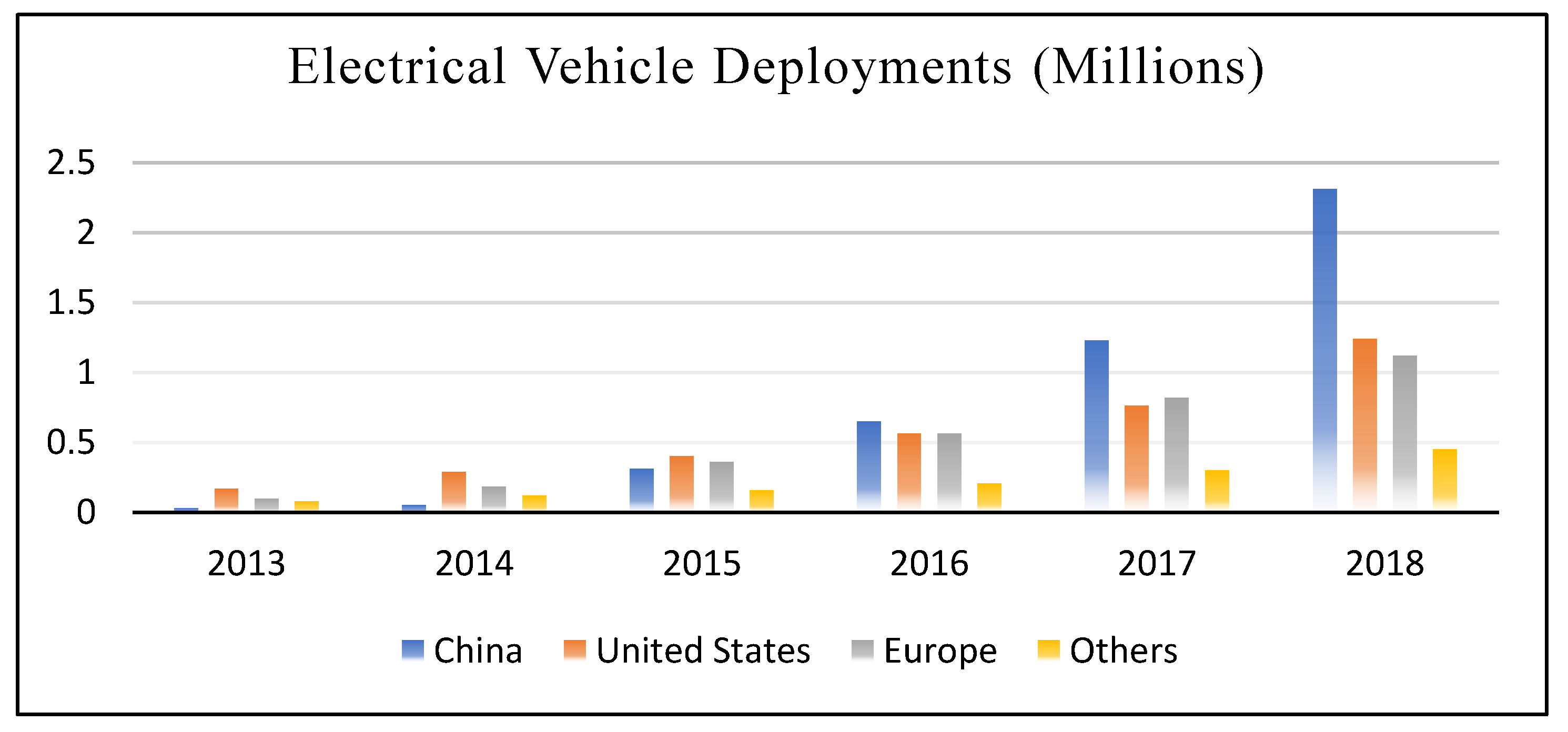
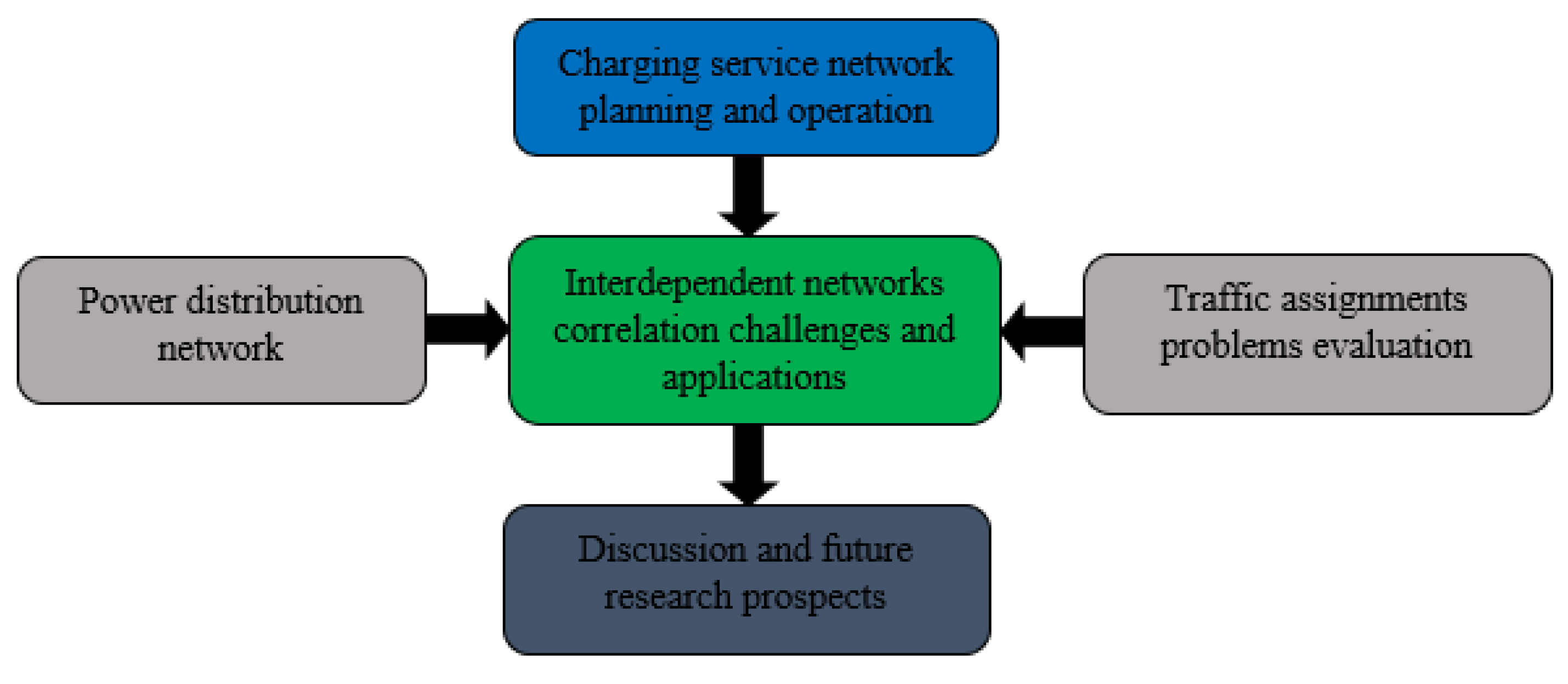
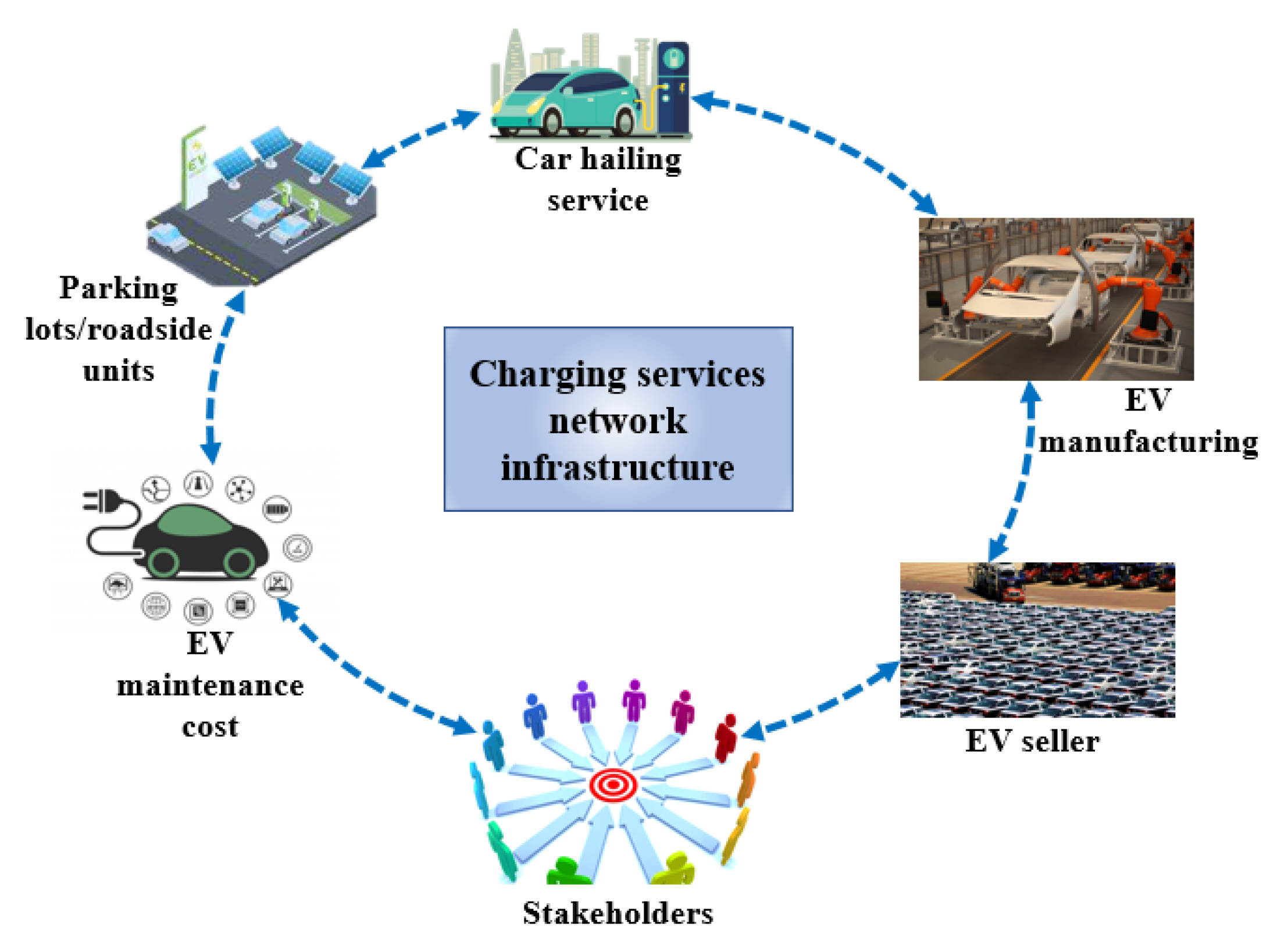
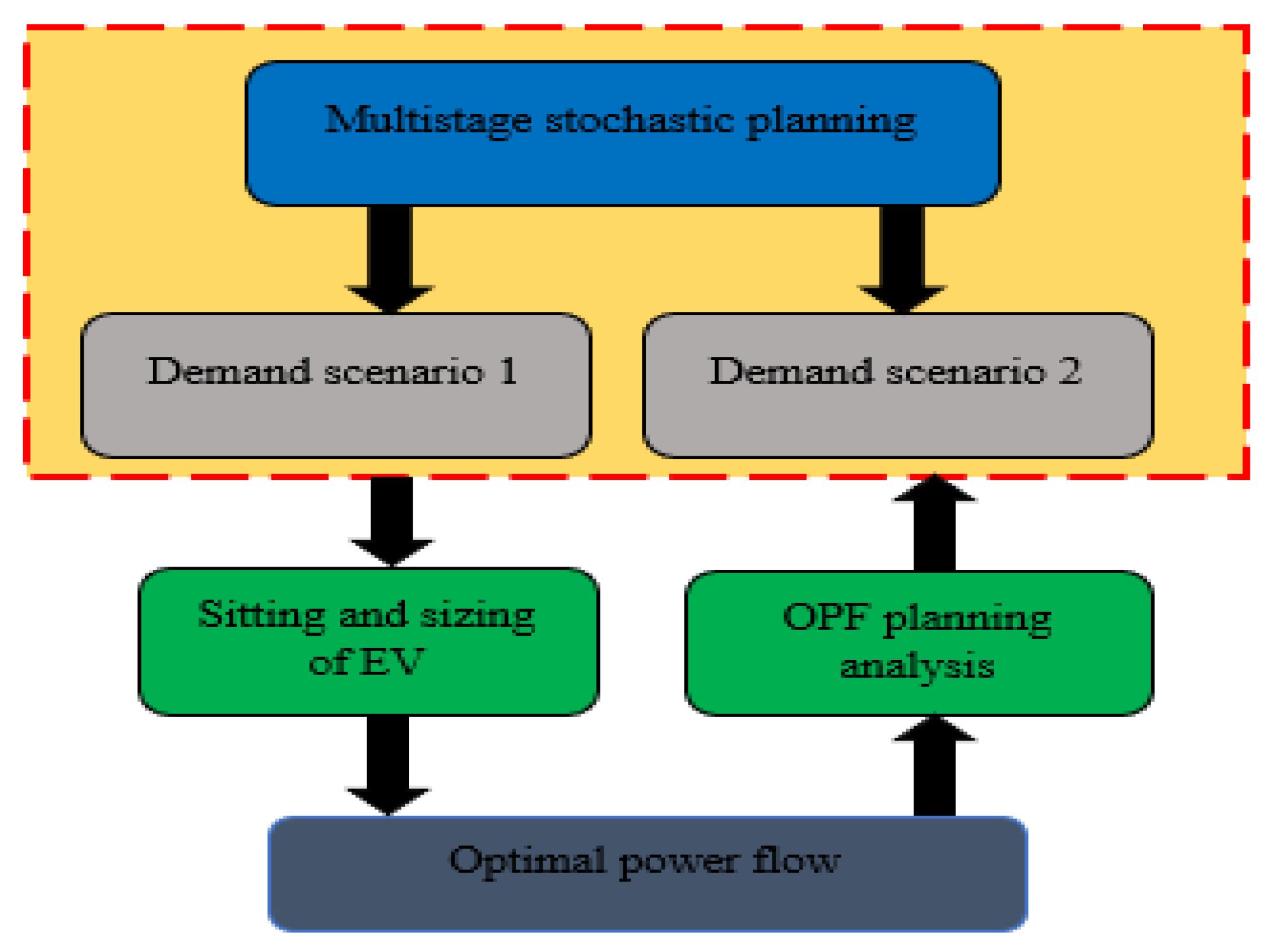
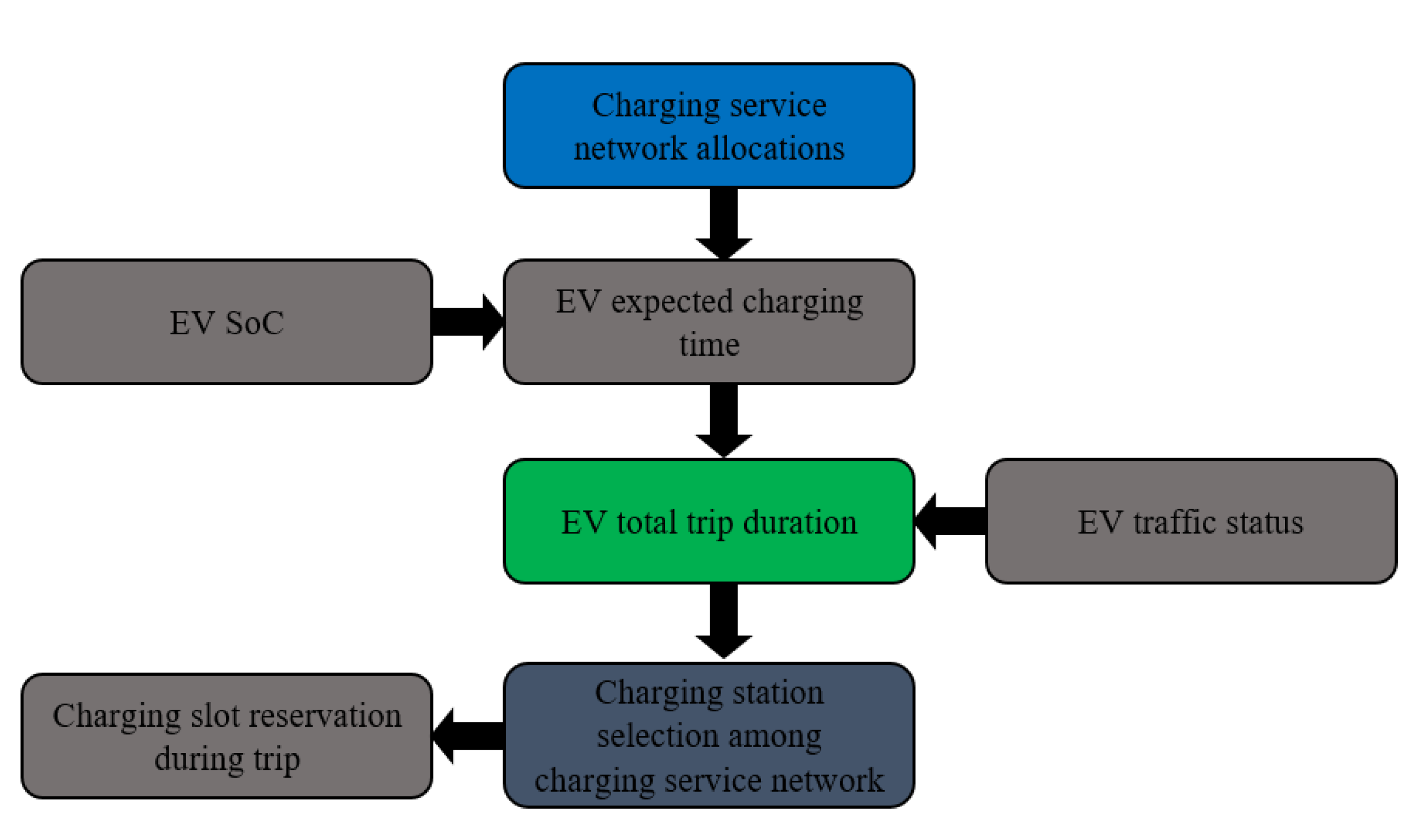
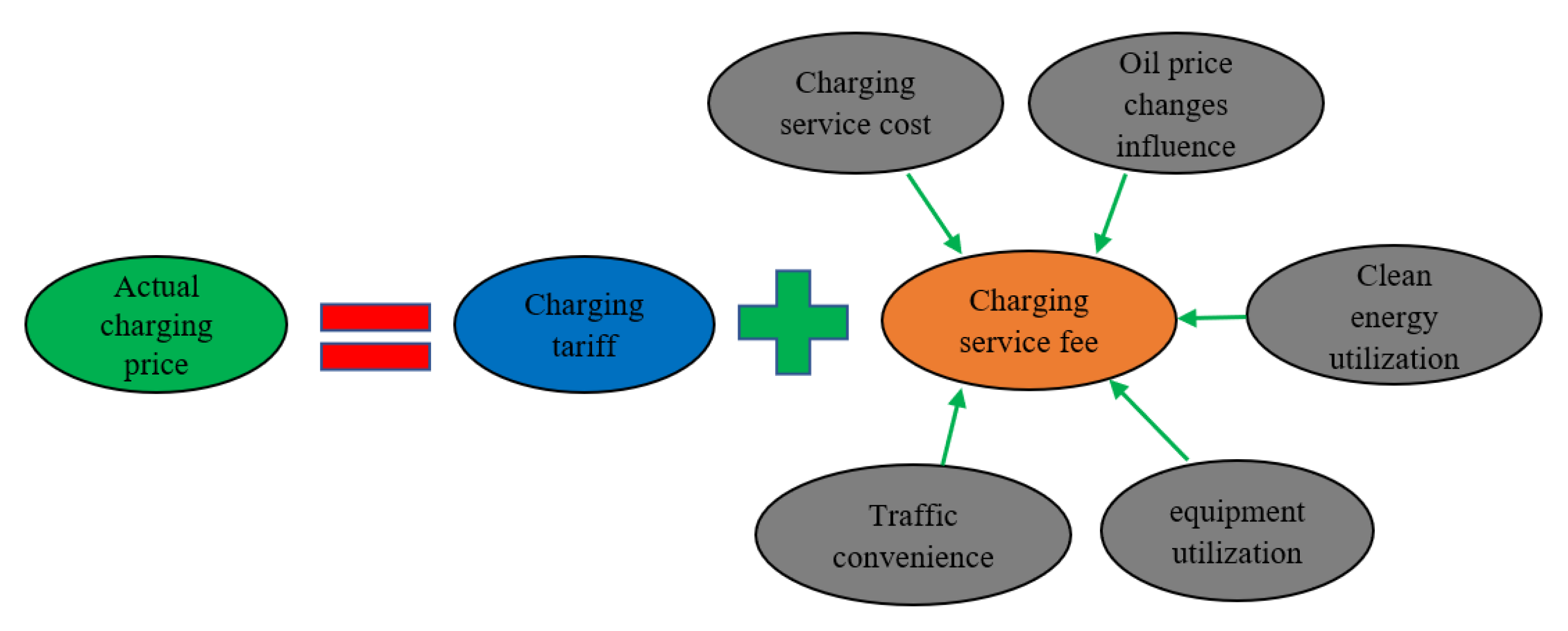


| Network Modelling Approach | Charging Coordination | Traffic Conditions Model | Distribution Network Model | Three- Networks Performance Index | References |
|---|---|---|---|---|---|
| MILP | ✓ | CFRLM | Power flow | ✗ | [128] |
| mixed-integer SOCP | ✓ | CFRLM | Branch flow | ✗ | [135] |
| Multi-objective non-linear | ✓ | UE | Power flow | ✗ | [137] |
| Two-stage stochastic program | ✓ | UE | SCUC | ✗ | [152] |
| MILP | ✓ | UTAM | Linearized Distflow | ✗ | [153] |
© 2020 by the authors. Licensee MDPI, Basel, Switzerland. This article is an open access article distributed under the terms and conditions of the Creative Commons Attribution (CC BY) license (http://creativecommons.org/licenses/by/4.0/).
Share and Cite
Jawad, S.; Liu, J. Electrical Vehicle Charging Services Planning and Operation with Interdependent Power Networks and Transportation Networks: A Review of the Current Scenario and Future Trends. Energies 2020, 13, 3371. https://doi.org/10.3390/en13133371
Jawad S, Liu J. Electrical Vehicle Charging Services Planning and Operation with Interdependent Power Networks and Transportation Networks: A Review of the Current Scenario and Future Trends. Energies. 2020; 13(13):3371. https://doi.org/10.3390/en13133371
Chicago/Turabian StyleJawad, Shafqat, and Junyong Liu. 2020. "Electrical Vehicle Charging Services Planning and Operation with Interdependent Power Networks and Transportation Networks: A Review of the Current Scenario and Future Trends" Energies 13, no. 13: 3371. https://doi.org/10.3390/en13133371
APA StyleJawad, S., & Liu, J. (2020). Electrical Vehicle Charging Services Planning and Operation with Interdependent Power Networks and Transportation Networks: A Review of the Current Scenario and Future Trends. Energies, 13(13), 3371. https://doi.org/10.3390/en13133371




